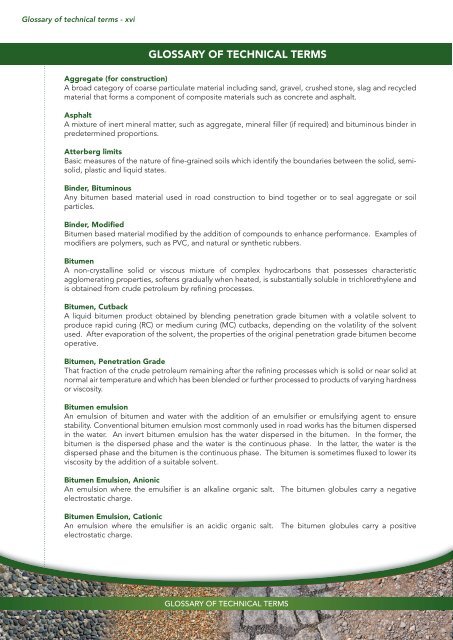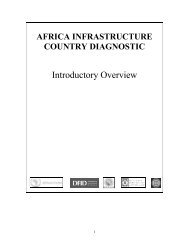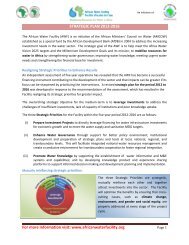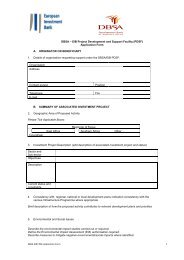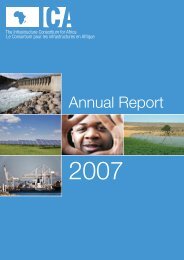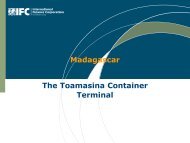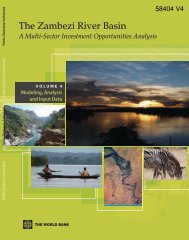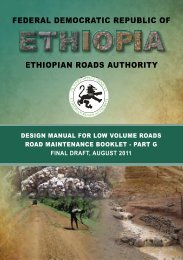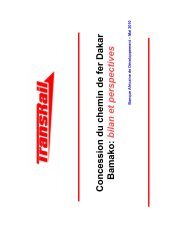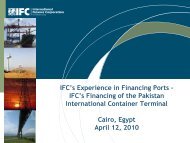Design-Manual-for-Low-Volume-Roads-Part-A
Design-Manual-for-Low-Volume-Roads-Part-A
Design-Manual-for-Low-Volume-Roads-Part-A
Create successful ePaper yourself
Turn your PDF publications into a flip-book with our unique Google optimized e-Paper software.
Glossary of technical terms - xvi<br />
GLOSSARY OF TECHNICAL TERMS<br />
Aggregate (<strong>for</strong> construction)<br />
A broad category of coarse particulate material including sand, gravel, crushed stone, slag and recycled<br />
material that <strong>for</strong>ms a component of composite materials such as concrete and asphalt.<br />
Asphalt<br />
A mixture of inert mineral matter, such as aggregate, mineral filler (if required) and bituminous binder in<br />
predetermined proportions.<br />
Atterberg limits<br />
Basic measures of the nature of fine-grained soils which identify the boundaries between the solid, semisolid,<br />
plastic and liquid states.<br />
Binder, Bituminous<br />
Any bitumen based material used in road construction to bind together or to seal aggregate or soil<br />
particles.<br />
Binder, Modified<br />
Bitumen based material modified by the addition of compounds to enhance per<strong>for</strong>mance. Examples of<br />
modifiers are polymers, such as PVC, and natural or synthetic rubbers.<br />
Bitumen<br />
A non-crystalline solid or viscous mixture of complex hydrocarbons that possesses characteristic<br />
agglomerating properties, softens gradually when heated, is substantially soluble in trichlorethylene and<br />
is obtained from crude petroleum by refining processes.<br />
Bitumen, Cutback<br />
A liquid bitumen product obtained by blending penetration grade bitumen with a volatile solvent to<br />
produce rapid curing (RC) or medium curing (MC) cutbacks, depending on the volatility of the solvent<br />
used. After evaporation of the solvent, the properties of the original penetration grade bitumen become<br />
operative.<br />
Bitumen, Penetration Grade<br />
That fraction of the crude petroleum remaining after the refining processes which is solid or near solid at<br />
normal air temperature and which has been blended or further processed to products of varying hardness<br />
or viscosity.<br />
Bitumen emulsion<br />
An emulsion of bitumen and water with the addition of an emulsifier or emulsifying agent to ensure<br />
stability. Conventional bitumen emulsion most commonly used in road works has the bitumen dispersed<br />
in the water. An invert bitumen emulsion has the water dispersed in the bitumen. In the <strong>for</strong>mer, the<br />
bitumen is the dispersed phase and the water is the continuous phase. In the latter, the water is the<br />
dispersed phase and the bitumen is the continuous phase. The bitumen is sometimes fluxed to lower its<br />
viscosity by the addition of a suitable solvent.<br />
Bitumen Emulsion, Anionic<br />
An emulsion where the emulsifier is an alkaline organic salt. The bitumen globules carry a negative<br />
electrostatic charge.<br />
Bitumen Emulsion, Cationic<br />
An emulsion where the emulsifier is an acidic organic salt. The bitumen globules carry a positive<br />
electrostatic charge.<br />
GLOSSARY OF TECHNICAL TERMS


